 |
|
At The Picture Show
|
May 2008
The need for 'Speed'
The Wachowskis' already-underrated 'Speed Racer' experiment pays off
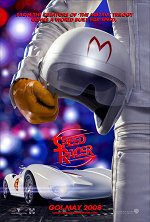
Speed Racer
Warner Bros. Pictures
Director: Andy Wachowski and Larry Wachowski
Screenplay: Andy Wachowski and Larry Wachowski, based on the animated series created by Tatsuo Yoshia
Starring: Emile Hirsch, Christina Ricci, Matthew Fox, Roger Allam, John Goodman, Susan Sarandon, Paulie Litt and Richard Roundtree
Rated PG / 2 hours, 15 minutes
Opened May 9, 2008



 (out of four)
(out of four)
Adaptation has, itself, adapted. Used to be, if you were taking something and
turning it into a movie, all you did was spruce it up a bit, take out the boring bits,
streamline the characters and change the ending.
Not completely necessary anymore. Through both technological advances and
pure experimentation, the literal adaptation has taken shape. Making one medium
look and feel and behave just like another. As if it were always a movie in the first
place.
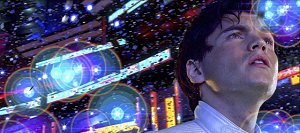 Warren Beatty started along this road 18 years
ago on Dick Tracy, with its deliberately cardboard backgrounds designed to
replicate comic-book frames.
Warren Beatty started along this road 18 years
ago on Dick Tracy, with its deliberately cardboard backgrounds designed to
replicate comic-book frames.
Then in 2005, Robert Rodriguez brought Frank Miller's Sin City to the big screen
- and essentially used the comics themselves as exact storyboards. There wasn't
even a screenplay credit. It was a comic book literally brought to life, an
interpretation of noir that had not been seen before - at least not on film.
Last year, Zack Snyder's 300 (another Miller comic) followed suit. And now,
here's the Wachowski Brothers' Speed Racer, which is designed to look exactly
like a cartoon without actually being one.
Movies work by movie rules, but maybe they don't have to. At least not in the
ways we're used to. Rodriguez certainly felt that way when he made Sin City,
finding that the only way to capture the world of the comics was to inhabit all of
its characteristics. Speed Racer achieves a similar effectiveness with its animation
aesthetic, even if it goes beyond what is technologically or narratively possible for
a Saturday morning cartoon.
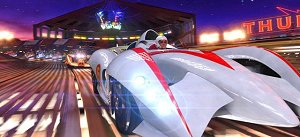 The intent, and the overall effect, is still there.
I can only assume that more experiments along this line - films that incorporate
the rules and specifications of entirely different media - are to follow.
The intent, and the overall effect, is still there.
I can only assume that more experiments along this line - films that incorporate
the rules and specifications of entirely different media - are to follow.
It's not just adaptation at this point. It's transfiguration. And it offers a radically
altered view of what can (should?) exist in cinema. It offers production designers,
cinematographers, directors, editors - in particular anyone involved in the visual
aspects of the film - a chance to adopt a new dialect to modern film language.
Using specialized cameras, layering techniques and green-screen technology, the
Wachowskis created Speed Racer to essentially be a live-action cartoon. (Some,
like myself, would argue that George Lucas did the same thing with his Star Wars
prequels, albeit unintentionally and unsuccessfully . . .and without restraint. But
that's another story.)
The effect is a jarring one - every frame is saturated with flashing neons and bold
blues, purples and reds. "Kaleidoscopic" doesn't even begin to say it. The world
the Wachowskis have created is a childlike, futuristic fantasy, sure - but one with
a mean streak, too.
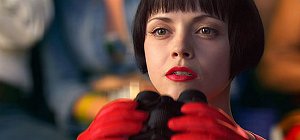 There's the wholesome family unit at the
center, the Racer Family - Speed (Emile Hirsch), the hotshot race-car driver; the
doting, pancake-cooking Mom (Susan Sarandon); Pops (John Goodman), who
runs the family's racing business - and on the other side, there's the insidious
corporate conglomerate, led by the delightfully odious Mr. Royalton (Roger
Allam), trying to buy Speed Racer's soul with the promise of trophies and riches.
There's the wholesome family unit at the
center, the Racer Family - Speed (Emile Hirsch), the hotshot race-car driver; the
doting, pancake-cooking Mom (Susan Sarandon); Pops (John Goodman), who
runs the family's racing business - and on the other side, there's the insidious
corporate conglomerate, led by the delightfully odious Mr. Royalton (Roger
Allam), trying to buy Speed Racer's soul with the promise of trophies and riches.
Yes, it's a light commentary on America as Big Business - the overreaching arm
of corporate control infringing, by default, on the time-honored values of honor
and fair play. But mostly, it sets up a clear and simple good-vs-evil conflict that is
just going to have to be solved by chase scenes, double-crossings, booby traps,
shootouts and, yes, more chase scenes. (Hey, this is a racing movie.)
Speed Racer is hyperkinetic pop-art on steroids, and that's part of what makes it so
invigorating as a film. It's easy to brush it off as eye candy for the ADD-rattled
brain, but . . . well, like I said, it's easy to say that. But you'd be disregarding the
vibrant and spectacular world the Wachowskis have created for these characters -
and us, more importantly - to inhabit. You won't see a movie more confident in
itself all year.
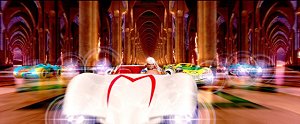 As they've proven before, the Wachowskis are
masters of action cinema, not just in the choreography of the action sequences but
in every detail of the way those sequences are crafted. How the bad guys got there,
what the bad guys are wearing, who's in conflict with who, time, place, etc. -
that's all got to be perfectly in place first, and then we get a great action scene or
two. Lesser filmmakers too often disregard the set-up to get right to the goods, but
not these guys.
As they've proven before, the Wachowskis are
masters of action cinema, not just in the choreography of the action sequences but
in every detail of the way those sequences are crafted. How the bad guys got there,
what the bad guys are wearing, who's in conflict with who, time, place, etc. -
that's all got to be perfectly in place first, and then we get a great action scene or
two. Lesser filmmakers too often disregard the set-up to get right to the goods, but
not these guys.
Some have denigrated Speed Racer as cheap consumerism passed off as retro
kitsch, akin to the postmodern irony of Starsky and Hutch or Dukes of Hazzard.
But that's not giving the Wachowskis nearly enough credit. Look, I was just as
disappointed in the way their Matrix series ended as you were, so I'm hardly ready
to give them a free ride just because they made the most influential sci-fi movie of
my generation.
But they haven't cut corners here. Their style is never compromised, always
exactly what they want it to be, never trying to be anything but itself. That's
always the case in their best work. I think their best film remains their directorial
debut, Bound, with its bold color scheme enhancing the Wachowskis' personal
take on film noir. Blacks, whites, greys and deep, dark reds are basically the only
colors in the entire movie - the only ones that matter anyway. The Wachowskis
seemed to be creating their own graphic novel-like aesthetic - only without any
pre-existing source material.
 With Speed Racer, the source material is
certainly there, and that's what we see on the screen: a larger-than-life facsimile of
a world that once could only exist on the small screen. This is what the original
Speed Racer could only dream of being.
With Speed Racer, the source material is
certainly there, and that's what we see on the screen: a larger-than-life facsimile of
a world that once could only exist on the small screen. This is what the original
Speed Racer could only dream of being.
Read more by Chris Bellamy